In the heart of every charming small farmhouse lies a kitchen that embodies warmth, nostalgia, and practicality. These intimate spaces, where the aroma of freshly baked bread mingles with the laughter of family and friends, are more than just cooking areas—they’re the beating heart of a home. Yet, designing a small farmhouse kitchen that maximizes efficiency while maintaining its inviting charm can be a delicate balance. From clever storage solutions to thoughtful layout designs, this article explores innovative ideas that blend functionality with rustic beauty. Whether you’re renovating an existing space or dreaming of your ideal kitchen, join us as we uncover the secrets to creating a small farmhouse kitchen that is both charming and efficient, ensuring every meal shared feels like a celebration of home.
Embracing the Essence of a Farmhouse Kitchen
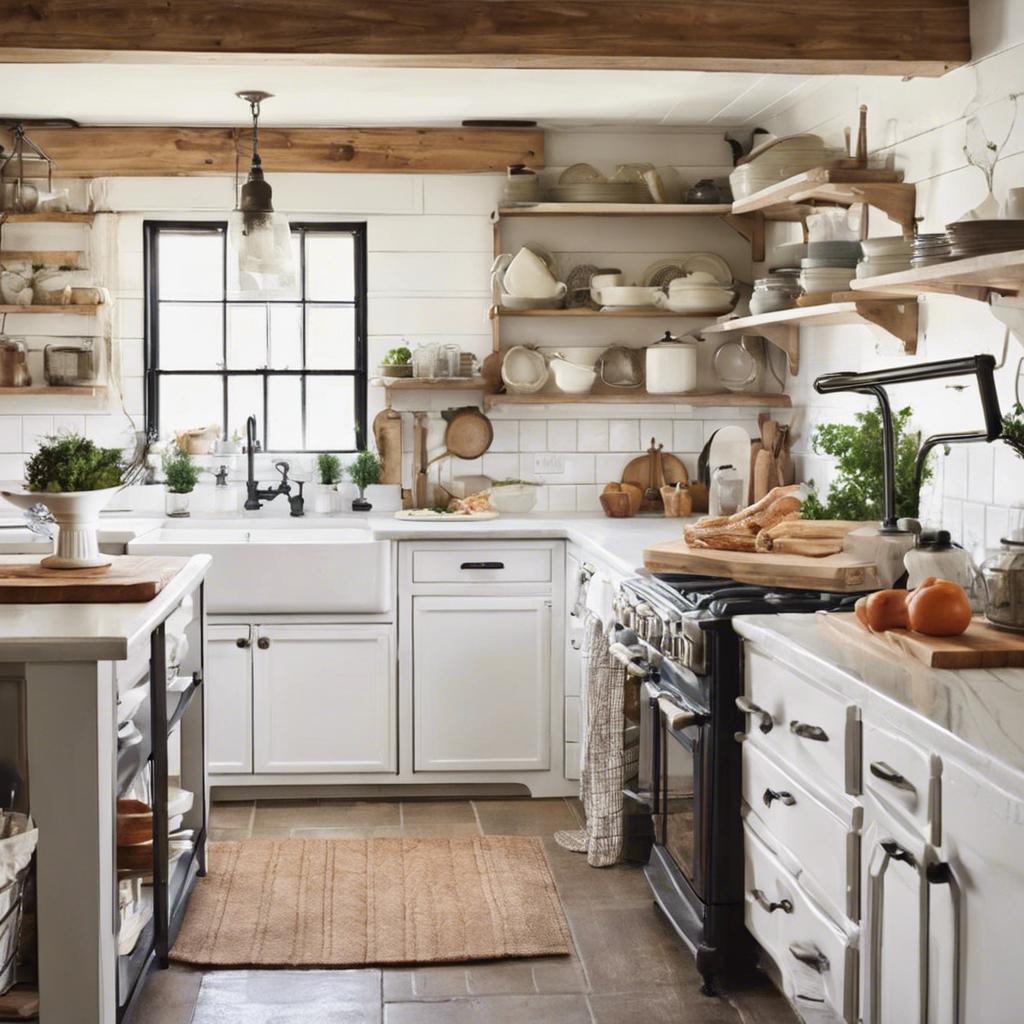
Incorporating the charming, rustic allure of a farmhouse kitchen can transform even the smallest of spaces into a cozy culinary haven. The heart of this design lies in its ability to balance functionality with aesthetics, ensuring that every inch counts while still exuding warmth and personality. Vintage appliances, open shelving, and natural materials such as wood and stone are essential elements that can easily enhance the ambiance. Introduce handmade pottery and heirloom pieces to personalize your space and create a story behind each item. The result is a kitchen that feels lived-in yet stylish, where every meal becomes a cherished occasion beyond mere sustenance.
Maximizing efficiency in a small farmhouse kitchen doesn’t mean sacrificing style. Clever storage solutions such as hanging pot racks and pull-out pantry shelves can free up precious counter space, while multifunctional furniture pieces, such as a kitchen island with built-in seating, offer both practicality and charm. Incorporate a color palette dominated by soft, muted tones, paired with pops of vibrant shades to invoke a lively yet serene environment. Consider a farmhouse table adorned with fresh flowers or homegrown herbs, making it the centerpiece where love for food and family converge.
Maximizing Space in a Cozy Farmhouse Kitchen
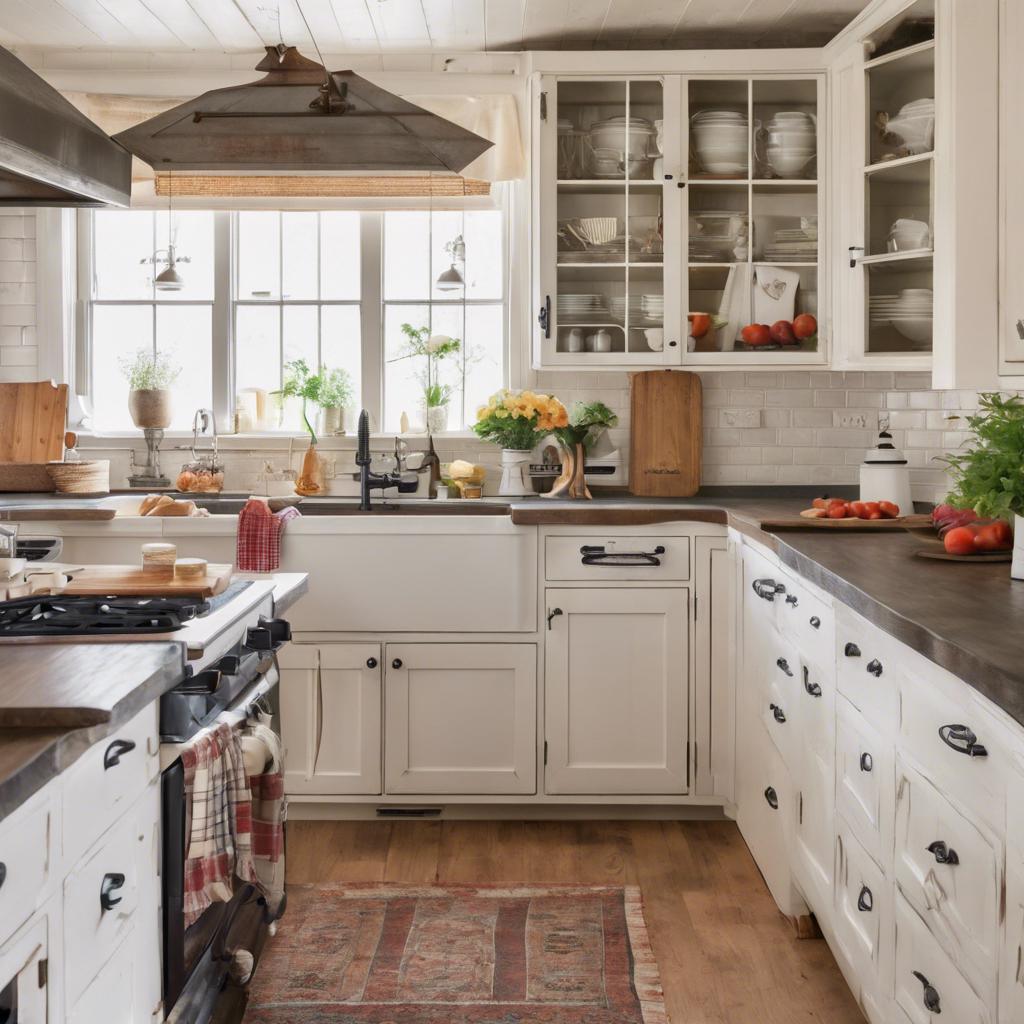
Transforming a small farmhouse kitchen into an efficient workspace is all about clever design choices that maximize every square inch. Utilize vertical space by installing shelves or cabinets that reach the ceiling, creating additional storage without sacrificing floor area. Incorporating built-in features such as a banquette with storage underneath can combine seating and functionality seamlessly. Consider a moveable island: it can serve as extra prep space and be easily relocated as needed, maintaining a fluid layout that adapts to different activities throughout the day.
Consider using multifunctional furniture that doubles as storage, such as bench seating or tables with hidden cubbies. Wall-mounted organizers for utensils and pots not only save space but add to the decor, enhancing that cozy rustic feel. To visualize your options, here’s a simple table highlighting some smart storage ideas:
| Storage Idea | Description |
|---|---|
| Open Shelving | Showcase dishes and decor while keeping essentials accessible. |
| Hanging Racks | Free up counter space with pot racks or pegboards. |
| Corner Cabinets | Maximize often-wasted corner areas with custom cabinetry. |
Color Palettes that Elevate Your Farmhouse Kitchen
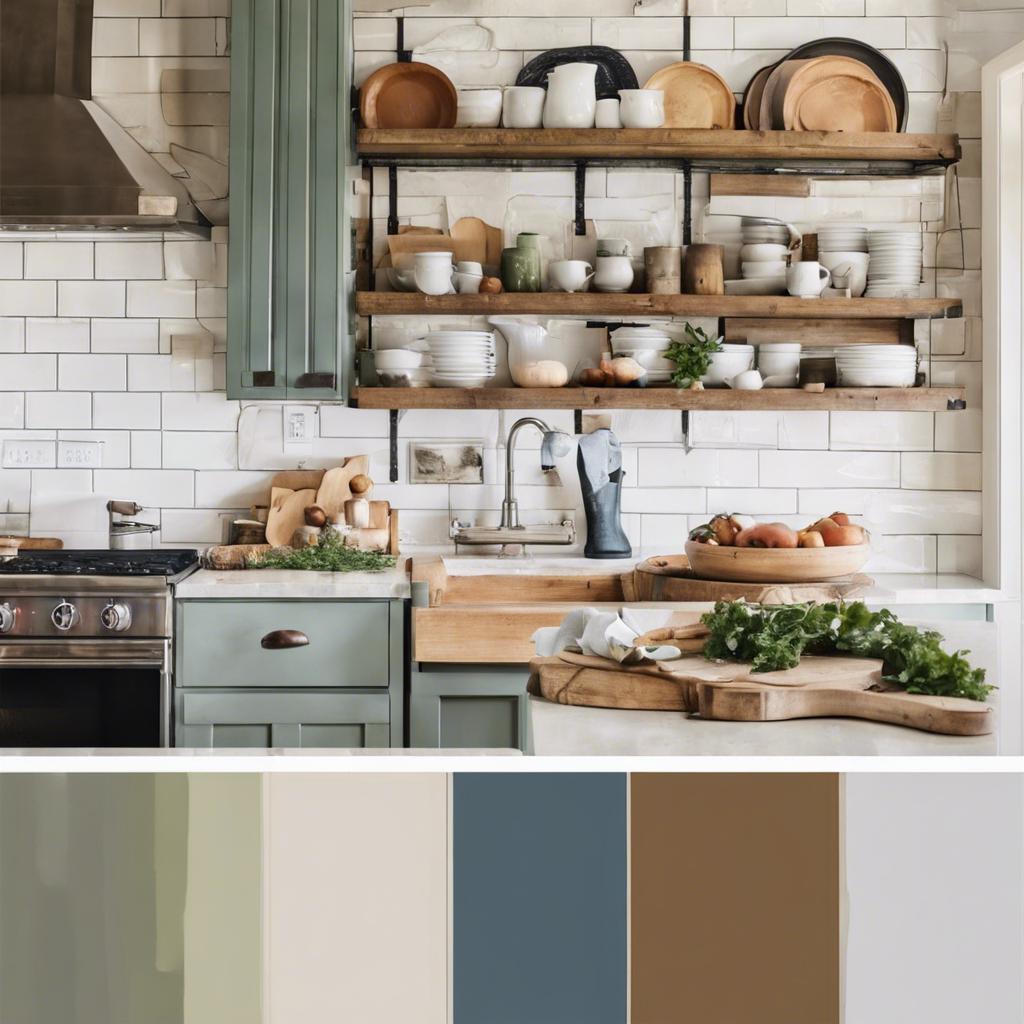
When it comes to maximizing the charm of a farmhouse kitchen, opting for the right color palette can make all the difference. Consider incorporating soft, muted tones that evoke a sense of warmth and comfort. Shades like dusty blue, sage green, and soft gray blend beautifully with natural wood tones and white accents, giving your kitchen an inviting and spacious feel. Pair these colors with traditional elements such as farmhouse sinks and vintage fixtures to create a cohesive look.
For those looking to add a bit of vibrancy without compromising the farmhouse aesthetic, pops of color can be strategically placed throughout the space. Think about using cheerful yellows, rich navy blues, or even warm terracotta in decor items like dishware, textiles, or accent walls. To illustrate the effectiveness of these combinations, here’s a simple table showcasing some engaging color pairings that can elevate your kitchen’s ambiance:
| Base Color | Accent Color | Recommended Use |
|---|---|---|
| Soft Gray | Rich Navy Blue | Cabinetry and Backsplash |
| Sage Green | Cheerful Yellow | Textiles and Decor |
| Dusty Blue | Warm Terracotta | Accent Walls and Accessories |
The Role of Natural Light in a Farmhouse Kitchen
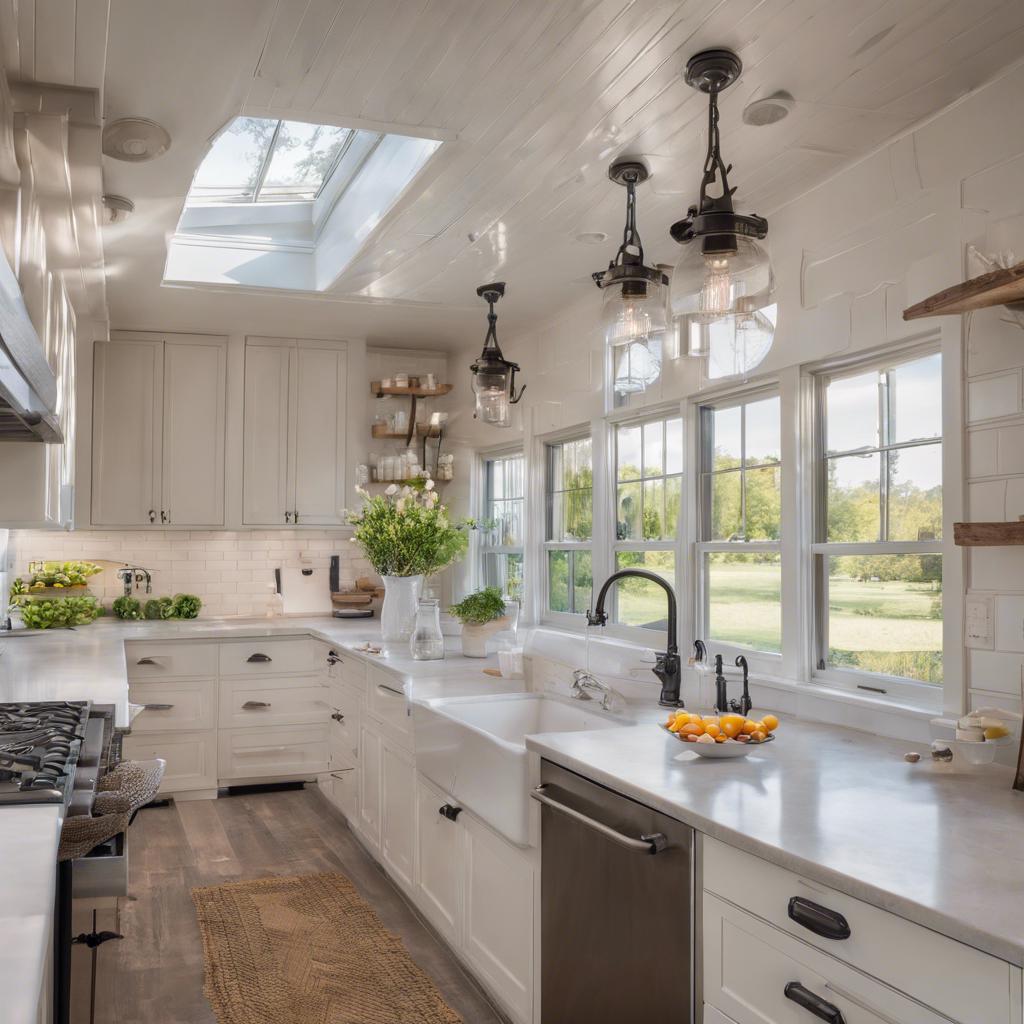
Natural light serves as an essential component in the design of any farmhouse kitchen, harmonizing aesthetics with functionality. Large windows and open layouts allow sunlight to flood the space, creating a bright and inviting atmosphere. This not only enhances the visual appeal but also serves practical purposes, such as reducing reliance on artificial lighting during the day. Incorporating features like skylights or glass doors can further maximize light, creating a seamless connection between the indoors and the serene outdoor landscapes typical of rural settings.
The presence of ample natural light can also influence the choice of color schemes and materials within the kitchen. Light-colored palettes, such as soft whites, gentle creams, or pale blues, can amplify the effect of sunlight, making the space feel airy and open. In contrast, deeper wood tones or rustic elements can provide warmth and contrast, creating a cozy ambiance. Consider the following features that complement natural light:
- Open shelving: Displays colorful dishes and herbs, catching the light.
- Mirrored accents: Reflect sunlight and amplify brightness.
- Textured fabrics: Light, breathable curtains can filter sunlight while adding a soft touch.
Choosing the Right Flooring for Your Farmhouse Kitchen
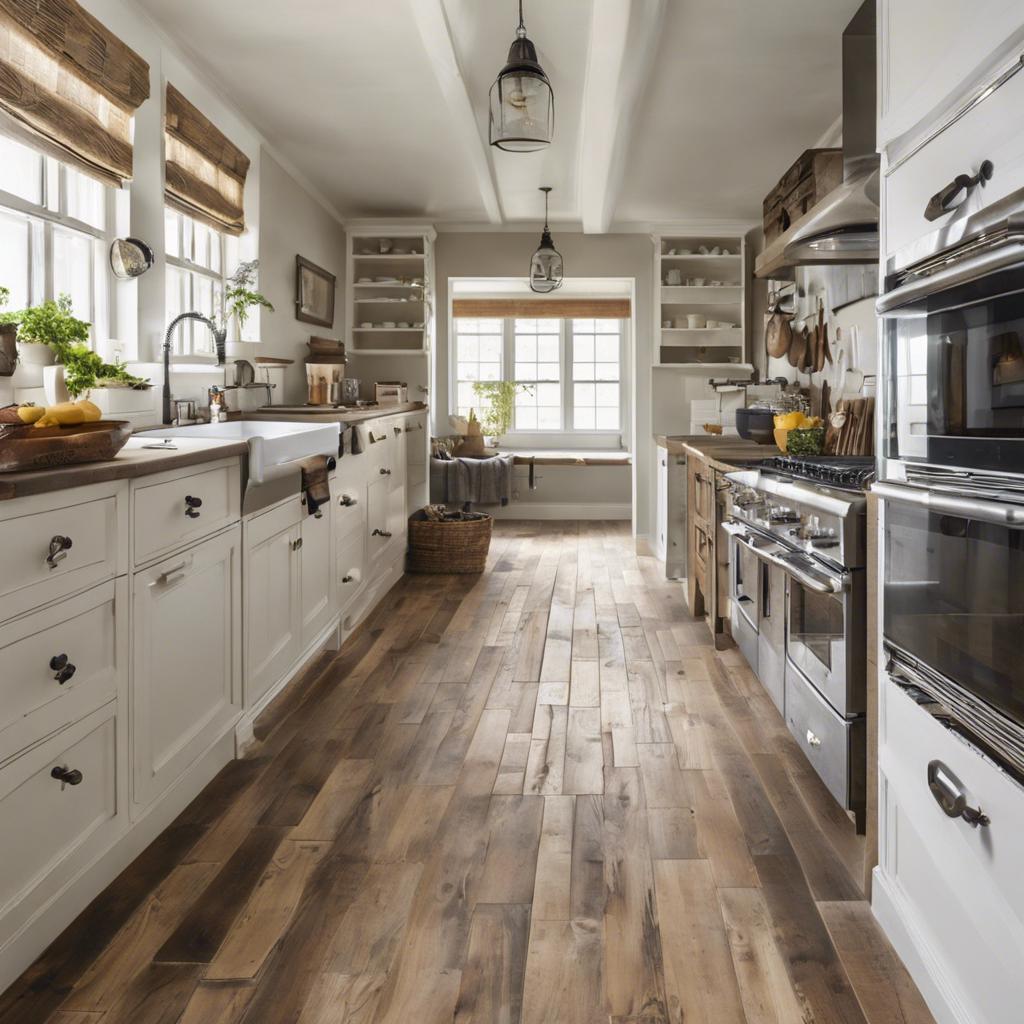
When selecting flooring for your farmhouse kitchen, consider the blend of aesthetics and practicality. Hardwood flooring adds warmth and charm, perfect for a rustic appeal. However, tile and vinyl offer durability and easy maintenance, which can be particularly beneficial in a high-traffic space. Here are some popular options:
- Wood – Classic and timeless, available in various finishes.
- Tile - Comes in numerous colors and patterns; ideal for easy cleaning.
- Laminate – Budget-friendly alternative to wood, resistant to scratches.
- Vinyl - Comfortable underfoot, with a wide array of designs mimicking natural materials.
Beyond materials, color and texture play vital roles in creating the desired atmosphere in your kitchen. Light, neutral tones can make the space feel more expansive, while darker shades can create a cozy, intimate environment. Consider how these elements will align with your overall design scheme. Here’s a helpful reference for choosing the right material based on your kitchen’s specific needs:
| Type | Durability | Maintenance |
|---|---|---|
| Wood | Moderate | Regular refinishing required |
| Tile | High | Minimal; grout lines may need cleaning |
| Laminate | Moderate | Easy; wipe clean |
| Vinyl | High | Low; just regular sweeping |
Smart Storage Solutions for a Small Farmhouse Kitchen
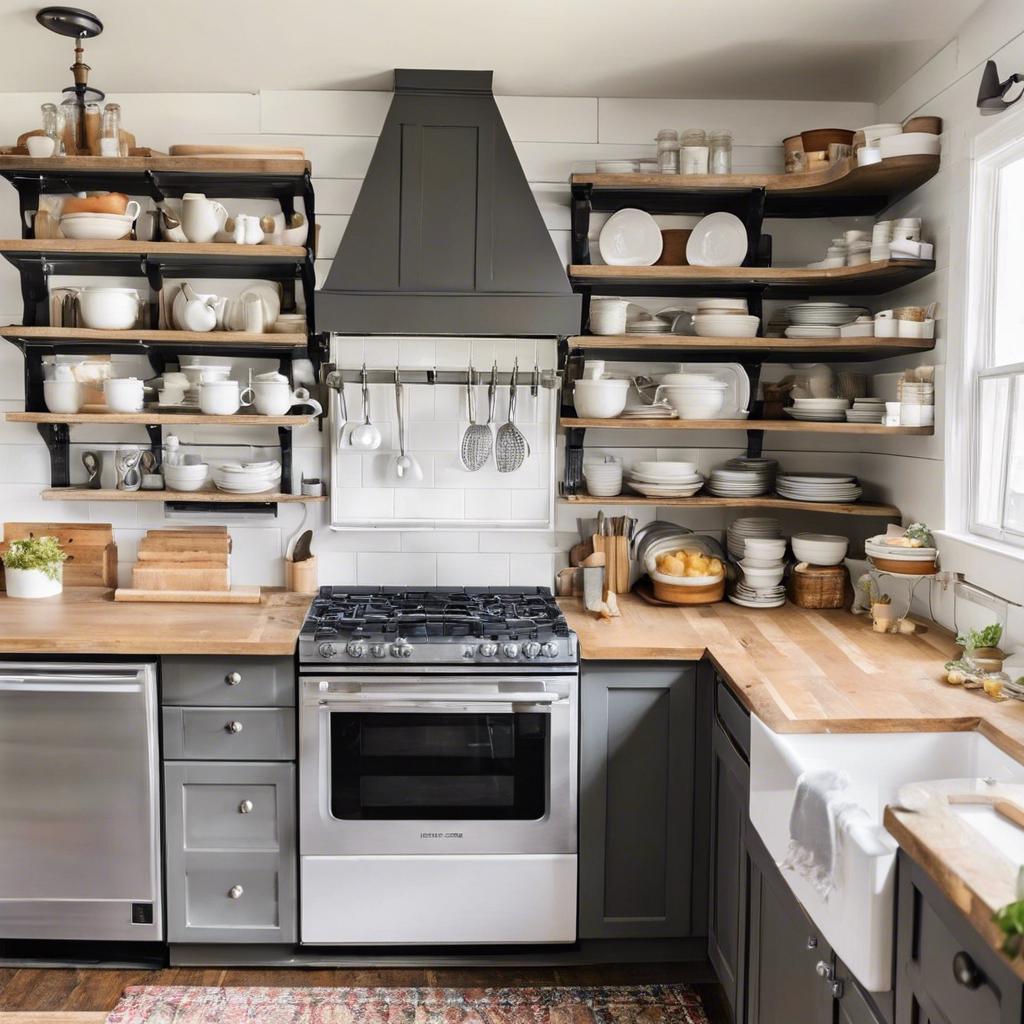
When space is at a premium in a small farmhouse kitchen, smart storage solutions become essential for maintaining a functional and charming environment. One effective approach is to maximize vertical space, which can be achieved by installing shelves that extend from floor to ceiling. These can be filled with rustic baskets that house smaller items or spice jars, marrying style with practicality. Consider the use of drawer dividers to keep utensils organized and easily accessible. Hanging pots and pans from a ceiling-mounted rack not only frees up counter space but also adds a touch of country elegance.
Incorporating repurposed furniture can also serve dual purposes in your cozy kitchen. A vintage ladder can become a unique shelving unit, perfect for showcasing cookbooks or houseplants, while an old farmhouse table could double as a prep station. To optimize corner storage, lazy Susans or pull-out shelves in deep cabinets can be employed, ensuring every inch is utilized efficiently. Additionally, utilizing the space above cabinets to display charming décor or more functional items like large jars can bring both life and organization into your culinary haven.
Designing an Open Concept Farmhouse Kitchen
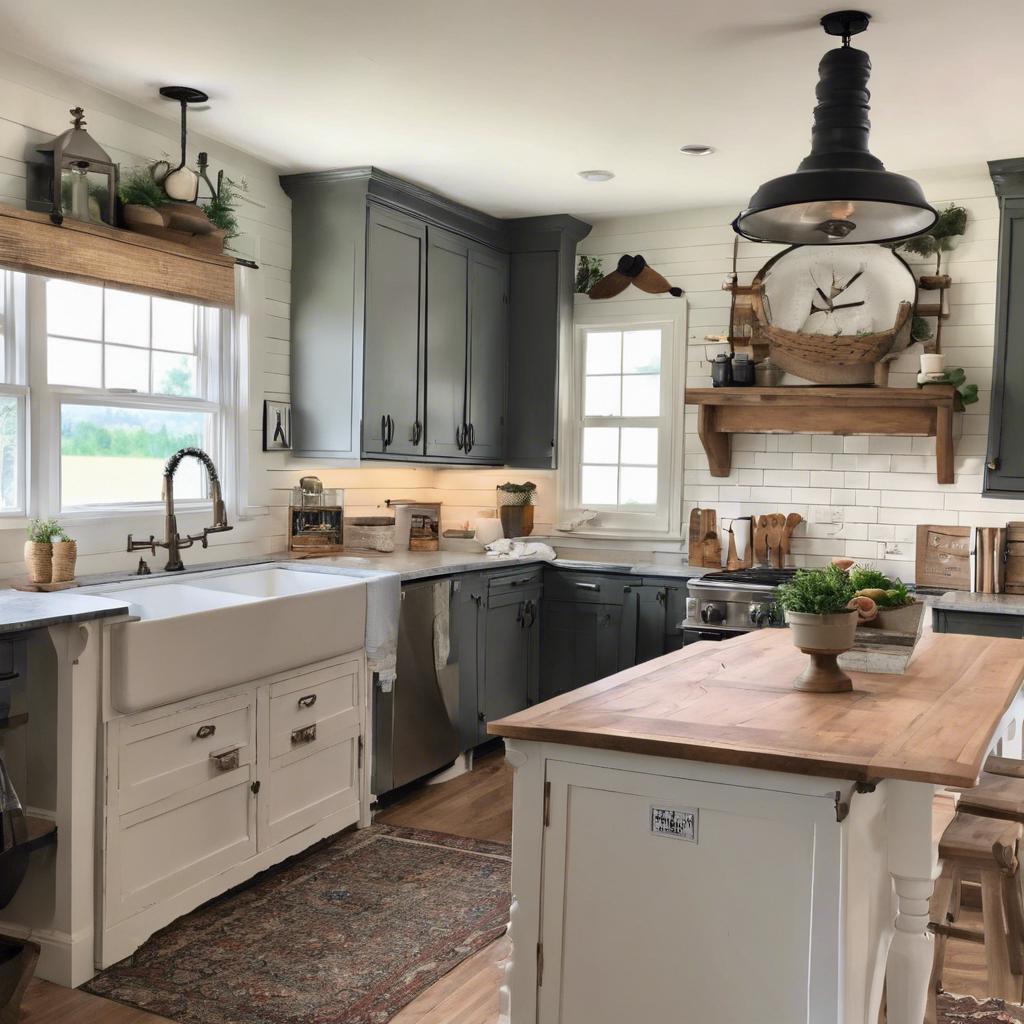
Creating an inviting farmhouse kitchen in an open concept design offers a perfect blend of functionality and charm. This style encourages a flow between spaces, allowing the kitchen to seamlessly integrate with the dining and living areas. To enhance this connection, consider using natural materials such as reclaimed wood for cabinetry and stone for countertops, which evoke a rustic feel while keeping functionality at the forefront. Incorporating large central islands not only provides ample workspace but also serves as a gathering spot for family and friends, creating a warm and welcoming atmosphere.
When it comes to color palettes, opt for soft, muted tones that promote a sense of calmness and serenity. Whites, creams, and pastels can create a light, airy feel, while accented barn doors or open shelving can bring a touch of countryside charm. Additionally, it’s essential to maximize the use of space by including smart storage solutions, such as pull-out drawers and built-in cabinetry, which can help keep the kitchen organized and clutter-free. A well-planned lighting design will enhance the ambiance, so consider a mix of pendant lights over the island and recessed lighting throughout to create a warm glow.
Incorporating Vintage Elements in Your Farmhouse Kitchen
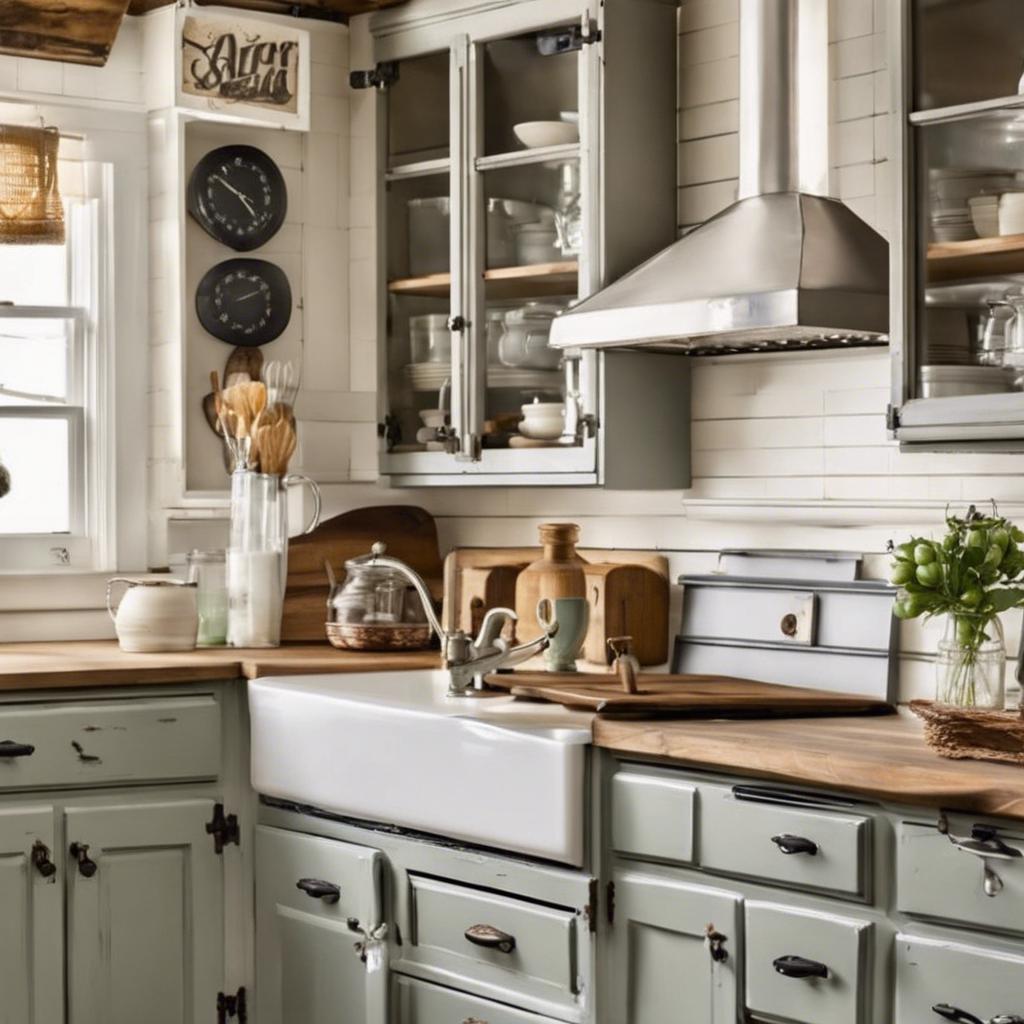
Integrating vintage elements into your farmhouse kitchen can create a cozy and timeless atmosphere that pays homage to traditional design. Consider incorporating antique furniture pieces, such as a reclaimed sideboard or a well-loved wooden dining table, that infuse character into the space. Utilizing vintage accessories like old jars, ceramic dishware, or a rustic bread box can enhance the overall aesthetic while adding functionality. Furthermore, choose hardware that reflects bygone eras, such as brass knobs or porcelain handles, to tie the look together seamlessly.
Another effective way to achieve a vintage look is through your choice of wall decor. A gallery of retro prints or a curated collection of vintage botanical illustrations can make an eye-catching statement. For those looking to make bold design choices, consider using wallpaper with classic patterns, such as damask or floral prints, to create a focal point. Utilizing reclaimed wood beams for open shelving not only adds charm but also showcases your treasured heirlooms or vintage finds in a practical manner.
Functional Island Designs for a Farmhouse Kitchen
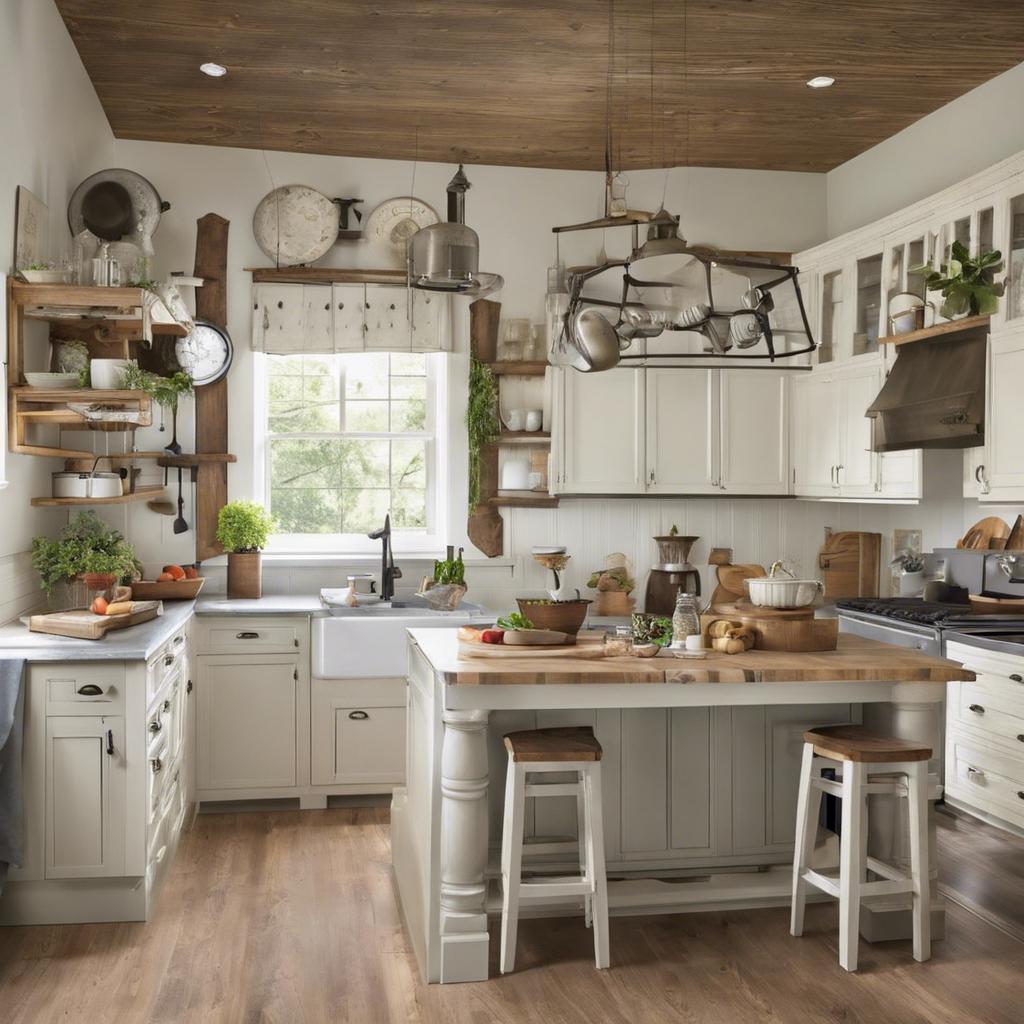
Integrating a functional island into a farmhouse kitchen not only enhances the aesthetic but also elevates its practicality. Consider an island that doubles as a prep space while functioning as a cozy dining area. The use of open shelving allows easy access to kitchen essentials, maintaining a rustic charm that complements the overall décor. Furthermore, incorporating features like built-in storage beneath the island can help keep the kitchen clutter-free, making it easier to manage daily tasks.
A harmonious color palette is key in the design of an island, with hues like soft whites, muted blues, or rustic greens contributing to the farmhouse vibe. Choose materials that evoke warmth and resilience; reclaimed wood for the island top paired with shaker-style cabinetry enhances the charming aesthetic while ensuring longevity. Additional touches such as pendant lighting above the island serve not only as an illuminating feature but also as a stunning focal point that ties the entire kitchen together.
Sustainable Materials for an Eco-Friendly Farmhouse Kitchen
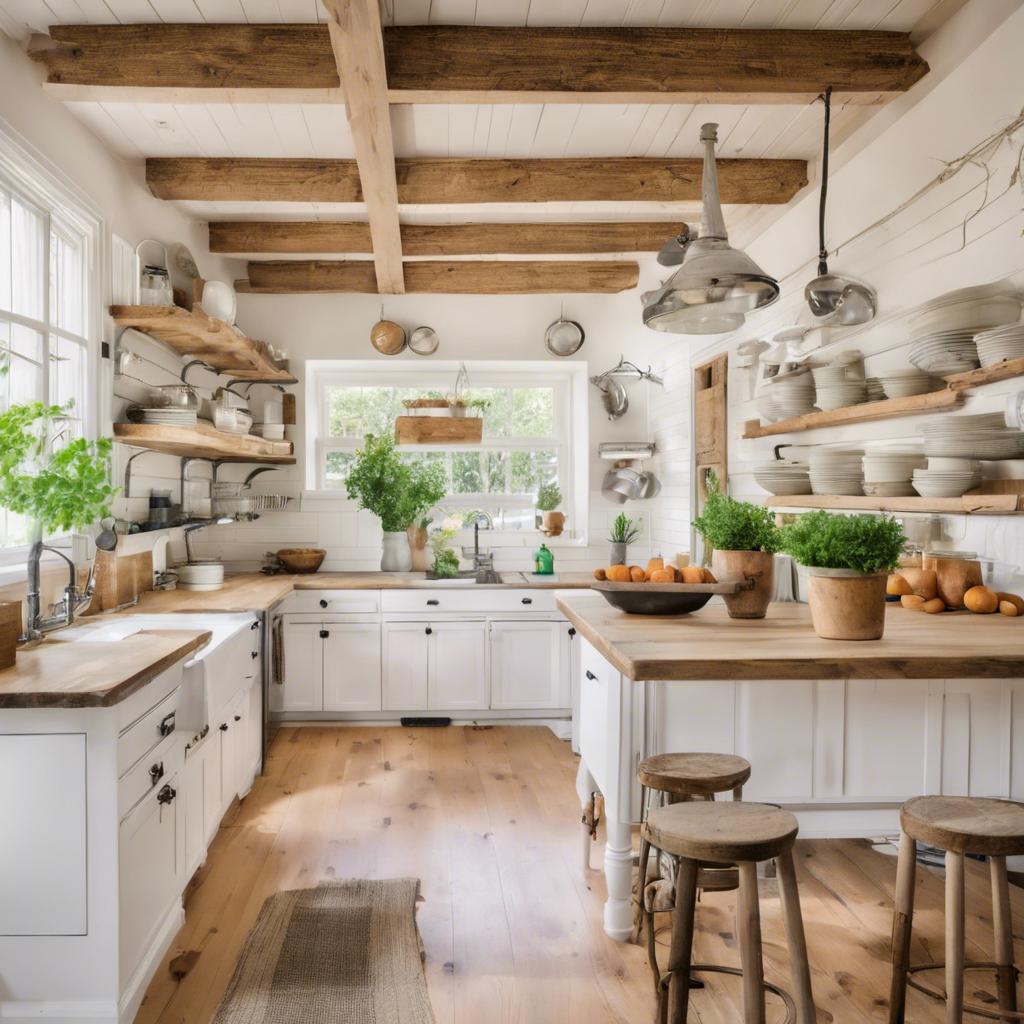
Creating an eco-friendly farmhouse kitchen is an exciting opportunity to incorporate materials that not only look beautiful but are also sustainable. Consider using reclaimed wood for cabinetry and countertops, as it adds character and history to your space while reducing the demand for new timber. Pair this with bamboo flooring, known for its rapid growth and renewability, which can provide a warm and inviting atmosphere. Other options include recycled glass tiles for backsplashes and countertops, which can bring a splash of color and pattern while being environmentally responsible.
Additionally, pay attention to the longevity and maintenance of your materials. Opt for low-VOC paints to minimize harmful emissions and improve indoor air quality, ensuring your kitchen remains a healthy environment. Incorporating natural stone for countertops can be a wonderful choice; its durability lasts through years of use, reducing the need for replacement. To further enhance the eco-friendly appeal, you might also consider outfitting your kitchen with energy-efficient appliances, which not only save on electricity but complement sustainable materials beautifully.
Efficient Layouts for a Compact Farmhouse Kitchen
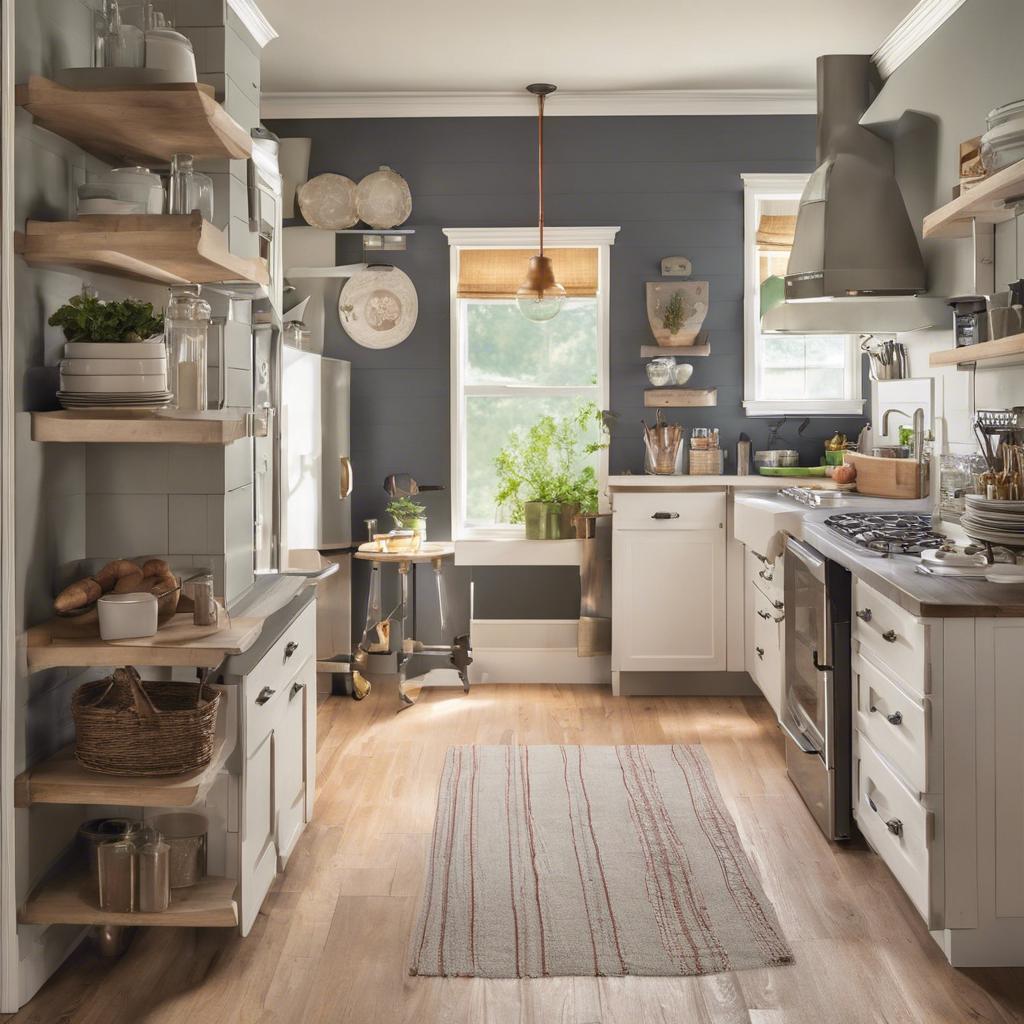
Maximizing space in a compact farmhouse kitchen is essential to create a functional yet cozy atmosphere. Consider adopting an open shelving concept, which not only provides easy access to frequently used items but also helps to visually expand the space. Incorporating multi-functional furniture, such as an island that doubles as a dining area or a breakfast nook, can also enhance usability without compromising on style. When selecting cabinetry, opt for lighter hues or glass-front designs to keep the space feeling airy and inviting. Additionally, utilizing corner cabinets and pull-out pantry systems can make the most of every square foot.
To further improve efficiency, plan your kitchen layout around the work triangle—the optimal arrangement of the stove, sink, and refrigerator. This configuration minimizes unnecessary movement and allows for a smoother cooking experience. Add in smart storage solutions like under-counter pullouts and overhead racks to keep everything organized. For a touch of charm, consider decorative accents such as patterned tiles or rustic lighting fixtures that complement the farmhouse aesthetic. Below is a simple table highlighting various layout ideas:
| Layout Type | Description |
|---|---|
| Galley | Two parallel counters create a streamlined workspace. |
| L-Shaped | Utilizes two adjacent walls, perfect for maximizing corner space. |
| U-Shaped | Surrounds the chef with cabinets, ideal for larger storage needs. |
Creating a Cozy Eating Nook in Your Farmhouse Kitchen

Transforming a corner of your farmhouse kitchen into a cozy eating nook can ignite warmth and charm in your home. Start with a small, round table that encourages intimate conversations and keeps the space feeling open. Enhance the ambiance with cushioned seating—think vintage benches or an eclectic mix of chairs that reflect your personality. Layer textures through soft throws and patterned pillows to create a welcoming retreat. Adding pendant lighting overhead can also set the mood, providing ample light while maintaining that rustic charm essential to a farmhouse aesthetic.
Consider personal touches to make the nook unique, such as a gallery wall of family photos or framed art that resonates with your style. Plants can breathe life into the area; small potted herbs or flowers on the table not only look beautiful but can also serve culinary purposes. For practical storage, a slim console table or open shelving nearby can house cookbooks and decorative dishes. These thoughtful elements combined will create a harmonious eating nook that ties the heart of your home together, celebrating both functionality and cozy elegance.
Essential Appliances for a Modern Farmhouse Kitchen
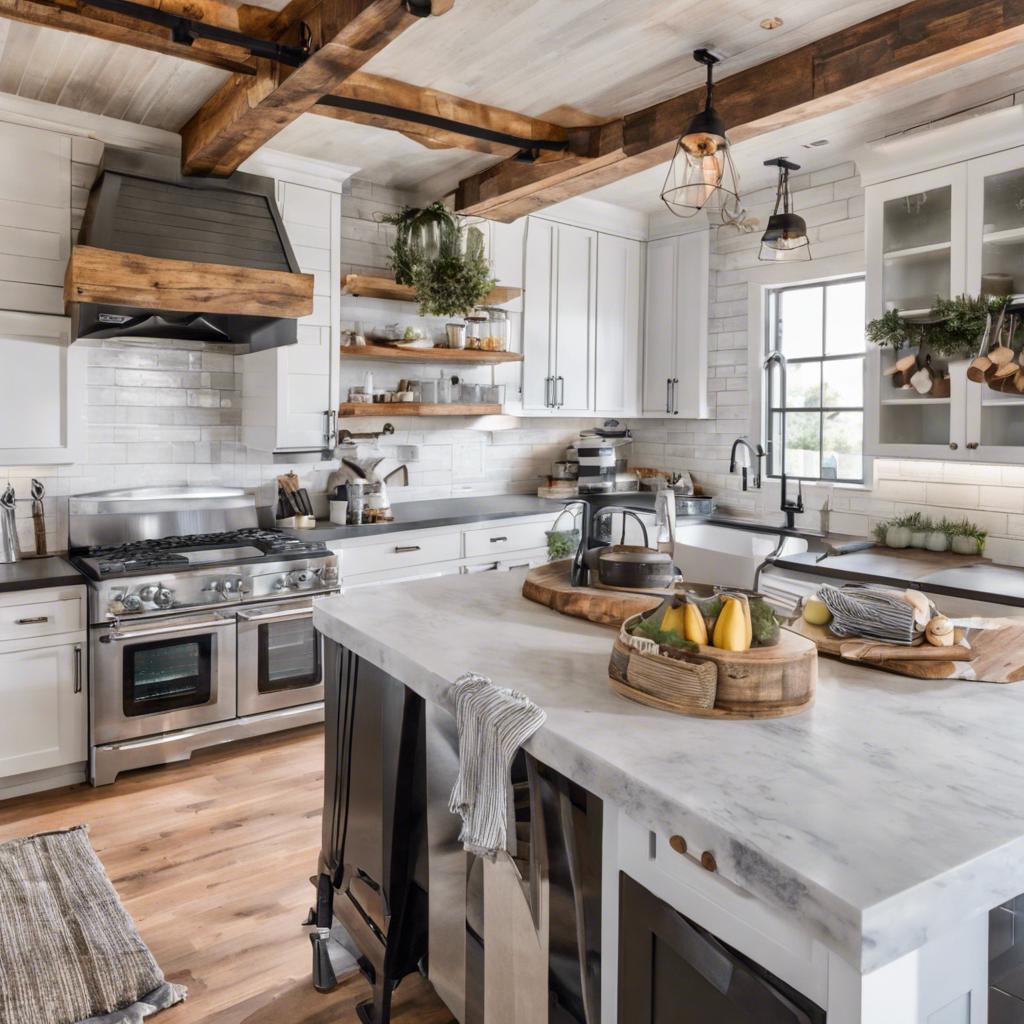
Creating a kitchen that balances charm and functionality is essential in a modern farmhouse. Key appliances serve not only to streamline cooking but also to maintain the aesthetic of rustic elegance. Consider incorporating a vintage-style refrigerator that melds retro looks with energy efficiency, providing ample storage while becoming a focal point of the room. A dual-fuel range can elevate both cooking and baking, allowing chefs to take advantage of the precision of gas and the even heating of electric ovens. Dishes come out perfectly every time, while the sleek design enhances the overall ambiance.
In addition to major appliances, smaller gadgets can enhance workflow and maintain a cozy atmosphere. Think about including a quality stand mixer that can be easily stored yet brought out for baking sessions, or a subtle coffee maker that complements your countertops without overwhelming the space. Consider a dishwasher with a front panel that matches your cabinetry, allowing it to blend seamlessly with the surrounding decor. These essential appliances not only improve efficiency but also contribute to a cohesive and inviting farmhouse aesthetic.
Rustic Décor Ideas to Enrich Your Farmhouse Kitchen
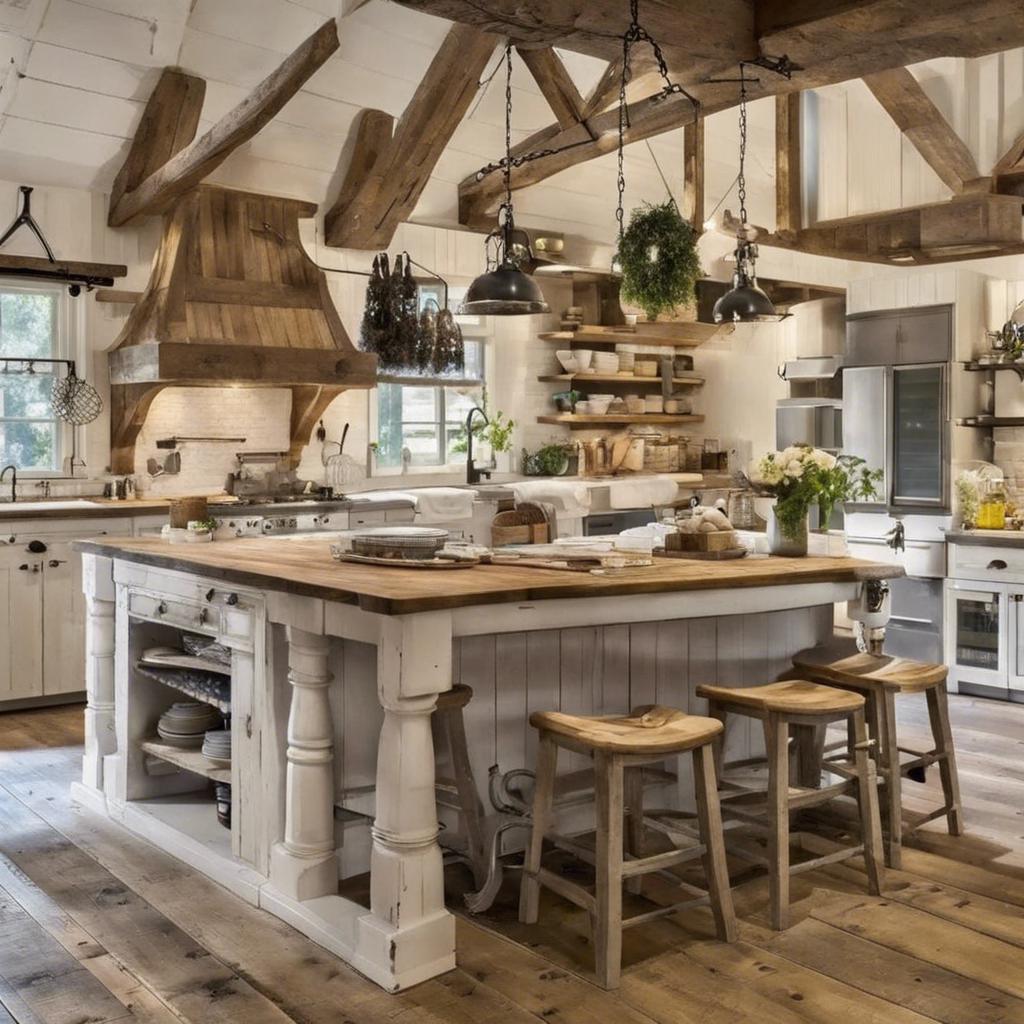
Transforming your farmhouse kitchen into a charming retreat is all about incorporating rustic elements that evoke warmth and simplicity. Start by adding reclaimed wood shelves to display curated collections of vintage kitchenware, which not only serve as functional storage but also make a lovely focal point. Complement these shelves with tin canisters for dry goods, keeping a cohesive and authentic feel throughout the space. Consider using farmhouse-style lighting fixtures, such as wrought iron chandeliers or pendant lights, to introduce a touch of elegance while maintaining that rustic charm.
To enhance the cozy atmosphere, integrate natural textiles such as burlap or linen in your kitchen accessories, from table runners to seat cushions. Incorporating handmade pottery or locally sourced items can also add character and a sense of place to your kitchen. Don’t forget to bring the outdoors in with fresh herbs, either in decorative pots or hanging planters, which not only add visual interest but also provide fresh flavors for your culinary creations. By thoughtfully layering these elements, your small farmhouse kitchen can embody both functionality and a distinctively rustic aesthetic.
Integrating Technology in a Traditional Farmhouse Kitchen
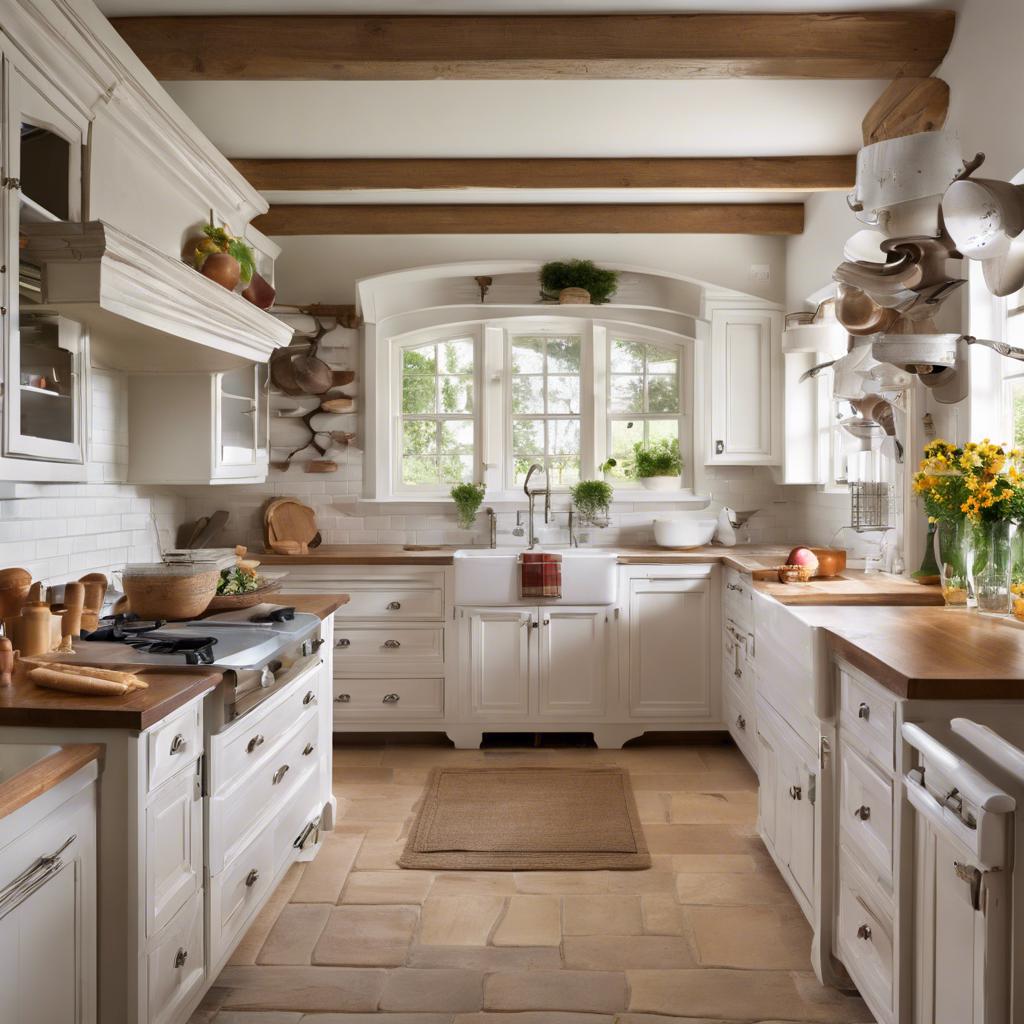
Incorporating technology into a traditional farmhouse kitchen can enhance both functionality and charm. Imagine an elegant blend of rustic wooden cabinetry paired with sleek, modern appliances that offer the best of both worlds. Integrative solutions like touchless faucets and smart refrigerators can streamline kitchen tasks while preserving the cozy, inviting atmosphere. Key elements to consider include:
- Smart Lighting: Use programmable LED lighting to set the perfect ambiance for cooking or entertaining.
- Bluetooth Speakers: Integrate music seamlessly into your kitchen for a more enjoyable cooking experience.
- Wi-Fi Enabled Appliances: Enhance efficiency with ovens and refrigerators that can be controlled remotely.
- Digital Recipe Displays: Montior your favorite recipes or cooking videos on a tablet or screen while you work.
To create a harmonious blend of the old and the new, design your kitchen layout to accommodate technology without sacrificing its quaint charm. Utilizing built-in tech features can save counter space while maintaining the aesthetic. Consider these design elements:
| Element | Description |
|---|---|
| Hidden Outlets | Install outlets inside drawers for a clean look without visible cords. |
| Integrated Devices | Choose appliances like dishwashers that blend seamlessly with cabinetry. |
| Smart Plugs | Utilize smart plugs for controlling countertop appliances remotely. |
Artisanal Backsplash Choices for Your Farmhouse Kitchen
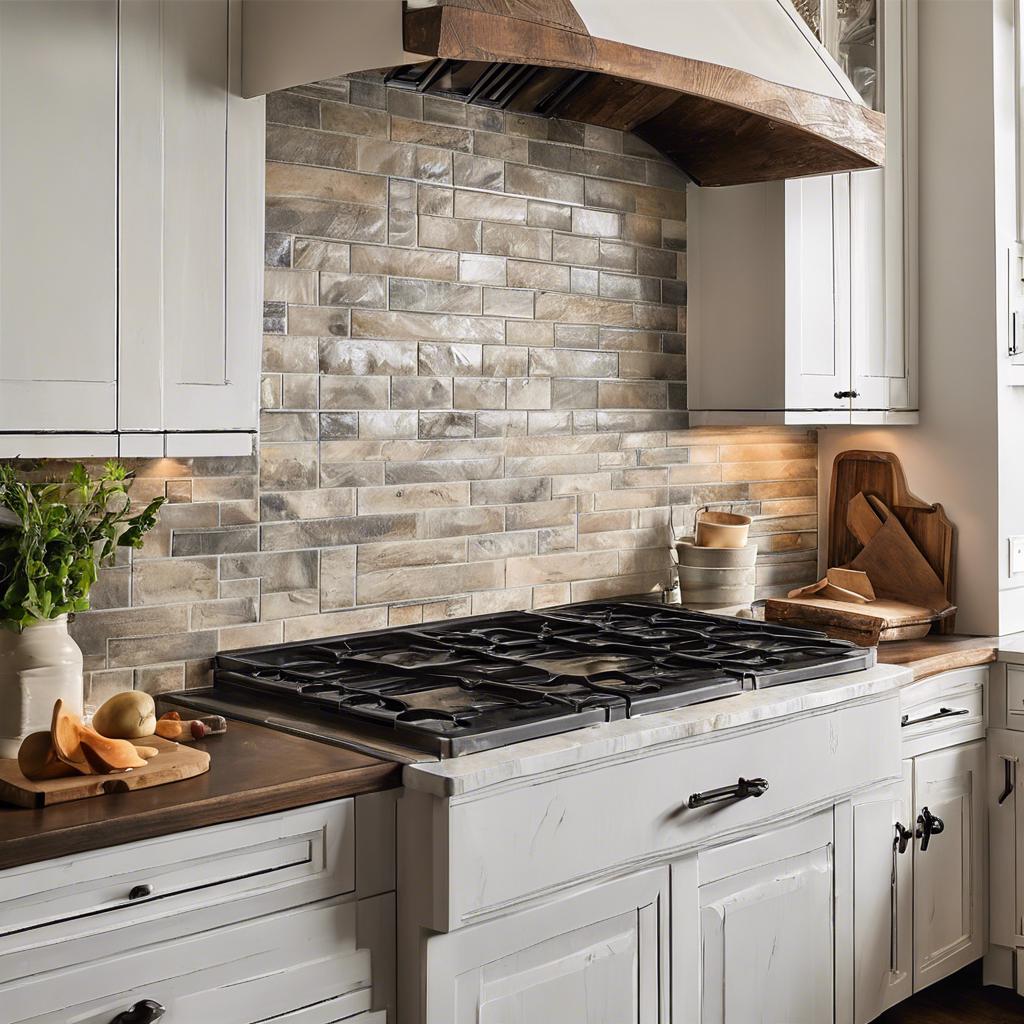
Transforming your farmhouse kitchen into an inviting space starts with selecting the perfect backsplash. Emphasize the charm of your kitchen with materials that tell a story, like reclaimed wood or vintage tiles, which not only exude a rustic flair but also add a personal touch. Consider options such as:
- Subway Tiles: Classic and versatile, they create a clean backdrop that complements farmhouse aesthetics.
- Handmade Ceramics: Each tile carries its own unique character, infusing the space with artisan craftsmanship.
- Natural Stone: For a more organic feel, opt for granite or slate that showcases natural variations and textures.
In addition to your primary backsplash, consider adding accents that enhance the overall design. This could include a decorative mural or a metallic strip to introduce a modern twist. Here’s a simple table showcasing complementary options:
| Material | Style Impact | Maintenance |
|---|---|---|
| Reclaimed Wood | Warmth and texture | Moderate |
| Glass Tiles | Bright and modern | Low |
| Encaustic Cement Tiles | Bold colors and patterns | High |
Mixing Textures for a Warm Farmhouse Kitchen Feel

To create an inviting atmosphere in your farmhouse kitchen, consider layering different materials that evoke warmth and comfort. Wood, metal, and textiles are key components that can marry functionality with aesthetic charm. Combining rustic elements like reclaimed wood cabinetry with sleek, industrial hardware can provide a delightful contrast. Soft textiles, such as linen curtains or a cozy apron, add not only a functional element but also a touch of softness that contrasts beautifully against harder surfaces.
Using a variety of textures can also enhance the overall design while drawing attention to specific areas within the kitchen. Consider the following:
- Countertops: Pair a smooth marble with a rough-hewn wooden island.
- Tile Backsplash: Use patterned ceramic tiles alongside subtly painted walls to create visual interest.
- Lighting Fixtures: Combine vintage pendant lights with modern LED strips for a multi-dimensional glow.
| Texture | Effect |
|---|---|
| Wood | Warmth and character |
| Metal | Industrial edge |
| Fabric | Softness and coziness |
Refreshing Your Farmhouse Kitchen with Foliage
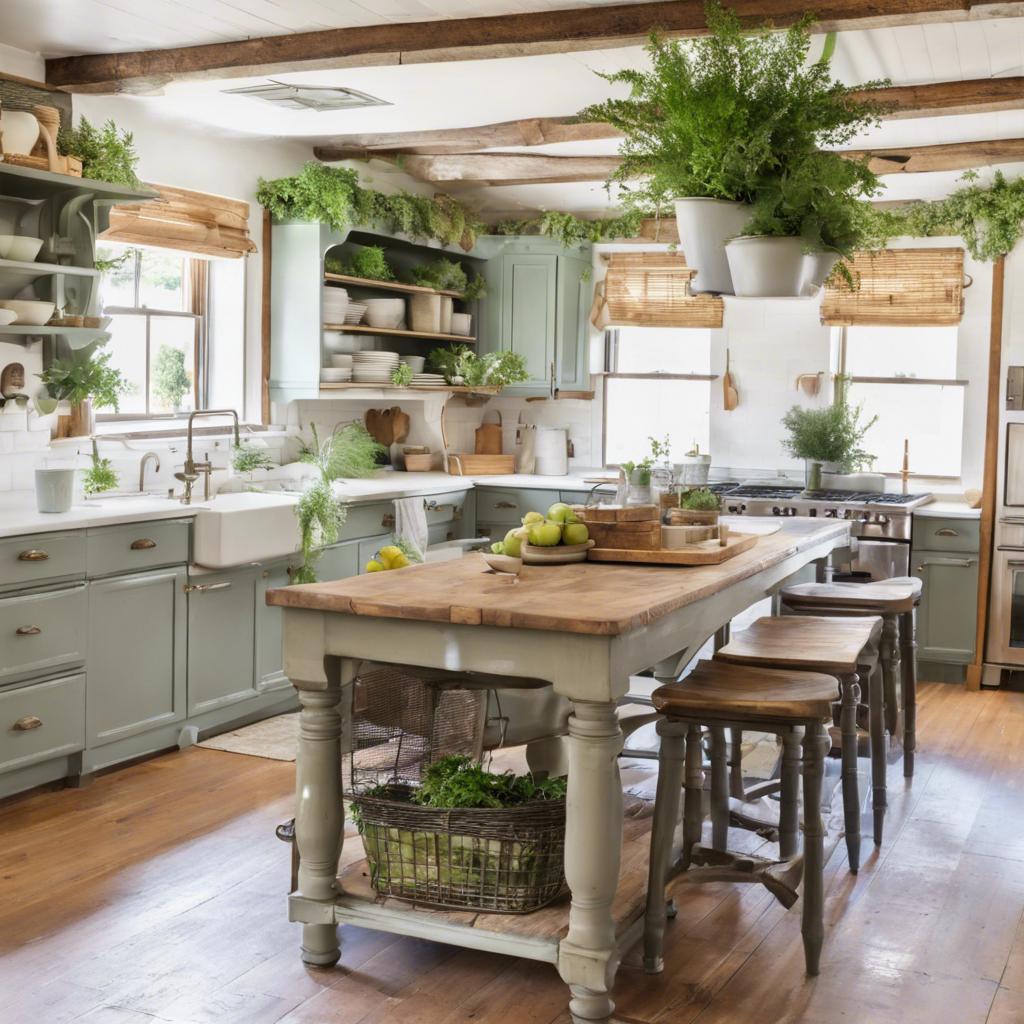
Incorporating greenery into your farmhouse kitchen can transform the space, infusing it with life and a sense of tranquility. To achieve this, consider using herbs and potted plants as a focal point on your countertops or windowsills. Not only do they add a pop of color, but they also provide fresh ingredients right at your fingertips. Try these options for a refreshing touch:
- Basil for its aromatic scent and culinary uses.
- Mint to add a crisp fragrance and versatile flavor.
- Succulents for low-maintenance beauty.
Elevate the aesthetic by utilizing vertical spaces to display hanging planters or wall-mounted shelves adorned with plants. This not only saves valuable counter space but also creates an inviting atmosphere. Consider arranging a small table with a collection of charming terracotta pots, or use a vintage ladder to showcase cascading plants. A well-placed table can provide functionality while enhancing your kitchen’s rustic appeal:
| Plant Type | Care Instructions | Ideal Location |
|---|---|---|
| Herbs | Water regularly, ensure ample sunlight | Windowsill or countertop |
| Succulents | Allow soil to dry out between watering | Semi-sunny spots |
| Hanging Plants | Water sparingly, avoid direct sunlight | High shelves or hooks |
Handcrafted Details that Enhance Your Farmhouse Kitchen
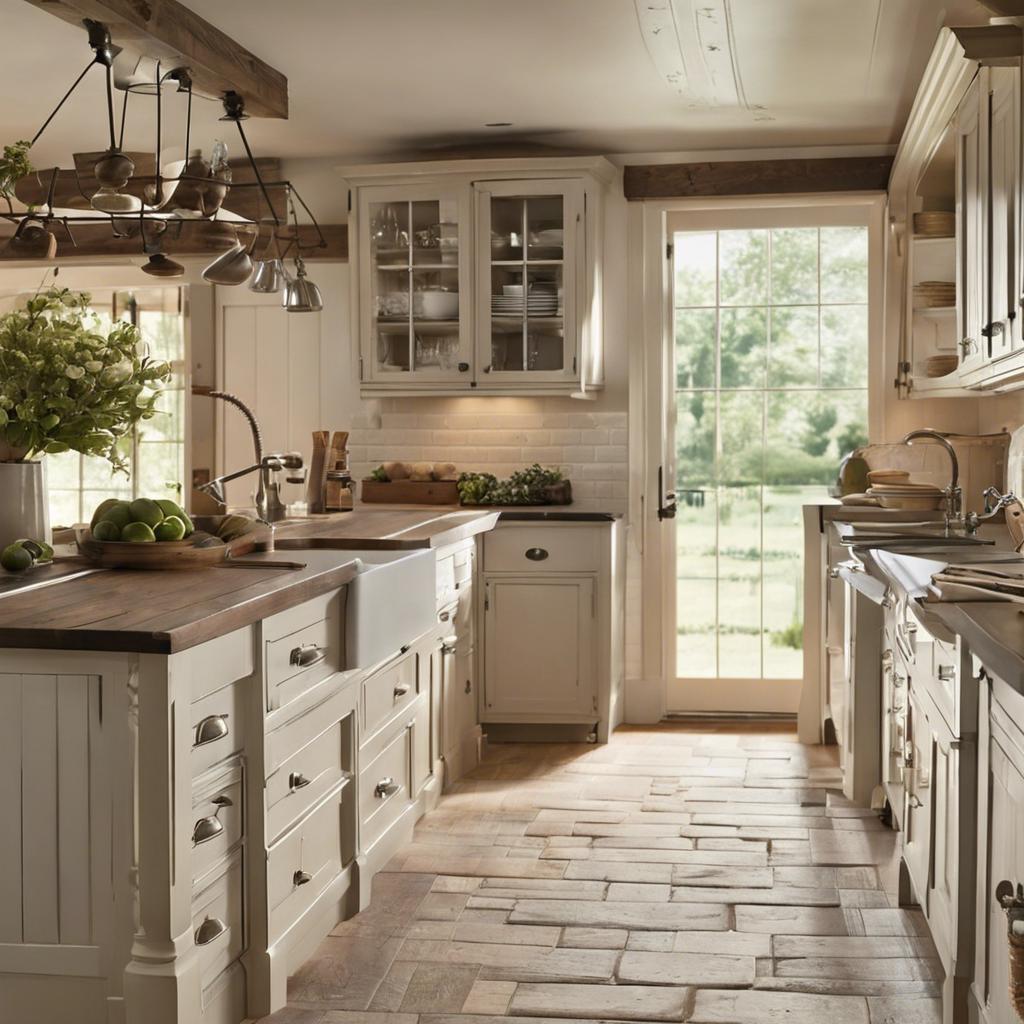
Incorporating handcrafted elements into your kitchen not only adds a personal touch but also elevates the charm of a small farmhouse space. Consider installing open wooden shelves made from reclaimed wood to display an assortment of vintage dishware, mason jars, or fresh herbs. The warmth of the wood contrasts beautifully with modern appliances, creating a homely yet sophisticated vibe. Other unique touches include handmade pottery pieces and artisanal cutting boards that serve as both functional tools and decorative accents.
To further enhance the farmhouse aesthetic, focus on details that reflect craftsmanship and timeless design. Utilize elements like hand-hammered metal fixtures or vintage-style cabinet knobs that echo the past while adding visual interest. A delightful centerpiece like a handcrafted table can act as the heart of the kitchen, inviting family gatherings and casual meals. Don’t forget the luxury of texture—soft linen curtains or a handwoven rug can marry comfort with style, creating a warm and inviting atmosphere perfect for any farmhouse kitchen.
Lighting Solutions to Brighten Your Farmhouse Kitchen
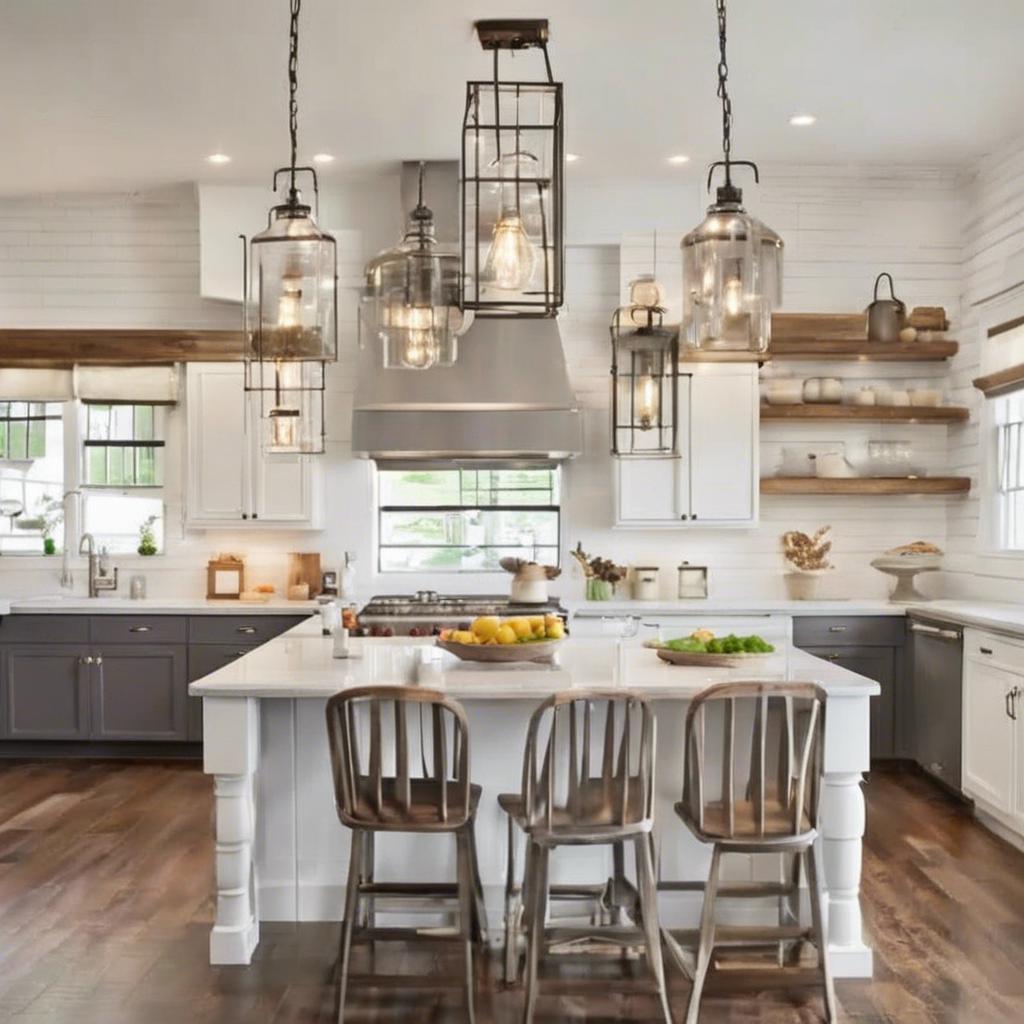
Illuminate your farmhouse kitchen with a blend of functional and aesthetic lighting choices that complement the rustic charm of the space. Consider installing pendant lights above your kitchen island or dining area to create a focal point while providing ample task lighting. Opt for fixtures with a vintage finish, such as brass or wrought iron, to enhance the cozy, country feel. Additionally, under-cabinet lighting can serve as a practical solution for preparing meals while adding an inviting glow to your countertops.
Don’t forget to layer your lighting for maximum effect. Incorporating dimmer switches allows you to adjust the brightness based on the time of day or mood, creating a versatile atmosphere. Incorporate wall sconces or table lamps in corners or on shelves for soft, ambient lighting that makes the kitchen feel warm and welcoming. Here’s a quick guide to explore different lighting types for your farmhouse kitchen:
| Lighting Type | Purpose | Aesthetic Style |
|---|---|---|
| Pendant Lights | Task lighting | Vintage, industrial |
| Under-Cabinet Lighting | Task lighting | Modern, sleek |
| Wall Sconces | Ambient lighting | Rustic, elegant |
| Table Lamps | Decorative and ambient | Farmhouse, eclectic |
Creating Functional Work Zones in Your Farmhouse Kitchen
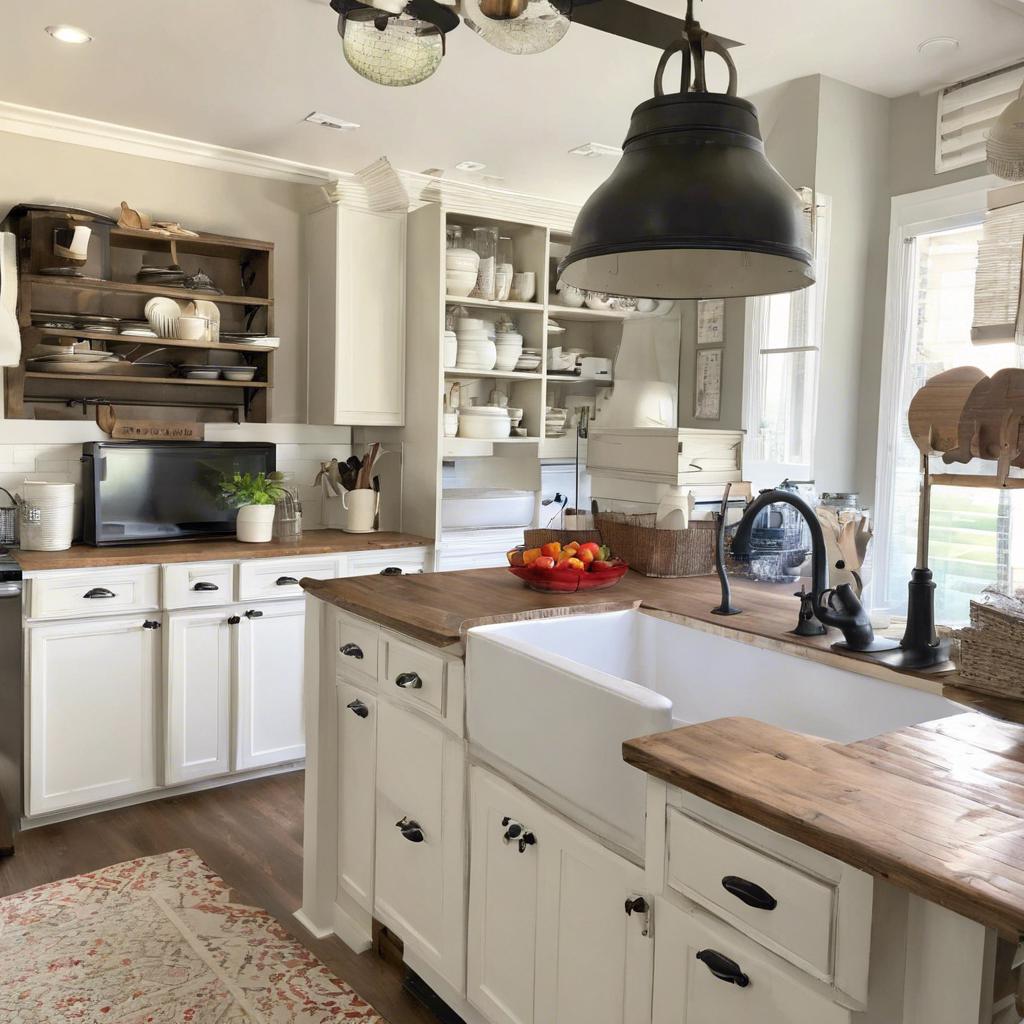
In a small farmhouse kitchen, maximizing functionality while maintaining charm is key. Zoning your space ensures that each area serves a unique purpose while harmonizing with the overall design. Consider establishing dedicated zones such as cooking, prep, and dining areas. For example, a well-placed kitchen island can act as a prep zone and a casual dining spot, utilizing both sides effectively. Incorporating open shelving or cabinets with clear organization in the cooking zone can streamline access to frequently used utensils and spices, enhancing efficiency during meal prep.
When organizing your work zones, utilize accessories that not only add function but also style. Visual dividers like area rugs can define spaces seamlessly without the need for structural changes. Take inspiration from the list below to enhance your kitchen’s functionality:
- Multi-functional furniture: Look for pieces that serve dual purposes, such as a butcher block table that offers cutting space and storage.
- Movable carts: Add flexibility with rolling carts for extra prep space that can be tucked away when not in use.
- Color coordination: Use color to visually separate zones; soft pastels for dining and richer tones for cooking create a comforting balance.
To further optimize your layout, consider this simple comparison of popular farmhouse kitchen features:
| Feature | Benefits |
|---|---|
| Open Shelving | Promotes easy access and creates a sense of openness. |
| Farmhouse Sinks | Offers functionality with a classic aesthetic; ideal for larger pots. |
| Built-in Benches | Provides cozy seating without consuming excessive space. |
Q&A
Q&A: Charming Small Farmhouse Kitchens – Efficient Design Ideas
Q1: What defines a farmhouse kitchen, and how can it be made to fit into a small space?
A1: A farmhouse kitchen is characterized by its warm, inviting atmosphere and a blend of rustic charm and modern practicality. To adapt this aesthetic for a small space, consider using open shelving to create a light and airy feel and incorporating vintage or reclaimed materials, such as barn doors or farmhouse sinks, which can serve as focal points without overwhelming the room.
Q2: What are some clever storage solutions for small farmhouse kitchens?
A2: Small farmhouse kitchens thrive on effective storage solutions. Think vertical! Use wall-mounted racks for pots and pans, magnetic strips for knives, and multi-functional furniture such as an island with built-in shelves. Additionally, consider utilizing the space under the sink and cabinets with pull-out drawers or baskets to maximize every inch.
Q3: How do color schemes contribute to the overall charm of a small farmhouse kitchen?
A3: Color plays a crucial role in enhancing the charm of a small farmhouse kitchen. Soft whites and neutrals can create a sense of openness, while pastels or muted colors add warmth without overpowering the space. Accent colors can be introduced through appliances, wall art, or even backsplash tiles to maintain a cozy yet vibrant environment.
Q4: What role does lighting play in a small farmhouse kitchen?
A4: Lighting is essential in small spaces, and in a farmhouse kitchen, it can highlight both functionality and charm. Natural light should be maximized with sheer window treatments. Additionally, pendant lights or vintage-inspired fixtures can provide both ambient and task lighting, making the space feel larger and more inviting.
Q5: Can you recommend some design elements that enhance the farmhouse vibe without taking up too much space?
A5: Absolutely! Incorporating design elements such as a farmhouse sink, butcher block countertops, or shiplap accents can add character without overwhelming the space. Wall art featuring farm-inspired themes or potted herb containers can also enhance the farmhouse aesthetic, offering charm and a touch of nature.
Q6: How can I make cooking in a small farmhouse kitchen more efficient?
A6: Efficiency in a small farmhouse kitchen can be achieved through intentional layout. Consider the kitchen work triangle, which optimizes the distance between the sink, stove, and refrigerator. Keep frequently used kitchen tools and ingredients easily accessible. Additionally, utilizing appliances that serve multiple functions can save space and time.
Q7: Are there any trends in small farmhouse kitchens worth noting?
A7: Yes, several trends are shaping small farmhouse kitchens today! Open-concept designs that connect kitchen and living spaces are becoming popular, as well as sustainable materials that enhance the rustic feel. Additionally, the use of mixed metals in fixtures and hardware adds a modern twist to classic designs, allowing personalization while maintaining that cozy farmhouse charm.
Q8: What are some common mistakes to avoid when designing a small farmhouse kitchen?
A8: One common mistake is overcrowding the space with too many decorative items or bulky furniture. Prioritize functionality while allowing for charm. Also, neglecting proper lighting can make the space feel cramped. Lastly, overlooking the flow and organization can lead to inefficiencies; ensure that all areas serve a purpose and flow seamlessly together.
Q9: How can I incorporate personal touches in my small farmhouse kitchen?
A9: Personal touches can make your small farmhouse kitchen truly unique! Consider displaying family heirlooms, like vintage cookbooks or kitchen utensils. Creating a gallery wall with framed photos or personal artwork can add warmth. Also, integrating your favorite colors or textures through textiles like dish towels, aprons, or even cushions can inject your personality into the space.
Conclusion
Embracing efficiency and charm in a small farmhouse kitchen is all about thoughtful design and personalized touches. With these ideas and insights, you can create a space that’s not only functional but also filled with warmth and character. Happy designing!
Closing Remarks
As we conclude our journey through the enchanting world of small farmhouse kitchens, it’s clear that these cozy spaces offer a delightful blend of charm and practicality. The art of efficient design, when infused with personal touches, transforms a modest kitchen into a welcoming heart of the home. From clever storage solutions to the strategic use of color and light, every detail plays a role in maximizing functionality while preserving that rustic allure.
Remember, a small kitchen doesn’t have to sacrifice style for efficiency. With careful planning and a touch of creativity, you can craft a space that reflects your personality and meets your culinary needs. Whether you’re a seasoned chef or a weekend warrior, your farmhouse kitchen can be a testament to both tradition and modernity.
As you envision your dream kitchen, let inspiration from these design ideas flow. Embrace the charm of farmhouse aesthetics and the joy of cooking in a space that feels uniquely yours. After all, the heart of the farmhouse is not just in its design, but in the warmth and love that fill it—making every meal a cherished memory. Happy designing!
